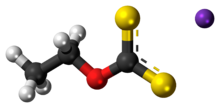


| |

| |
| Names | |
|---|---|
| Preferred IUPAC name
Potassium O-ethylcarbonodithioate | |
Other names
| |
| Identifiers | |
| |
3D model (JSmol) |
|
| ChEMBL | |
| ChemSpider |
|
| ECHA InfoCard | 100.004.946 |
| EC Number |
|
PubChem CID |
|
| UNII | |
CompTox Dashboard (EPA) |
|
| |
| |
| Properties | |
| CH3CH2OCS2K | |
| Molar mass | 160.29 g·mol−1 |
| Appearance | Pale yellow powder |
| Density | 1.263 g/cm3[1] |
| Melting point | 225 to 226 °C (437 to 439 °F; 498 to 499 K) |
| Boiling point | decomposes |
| Acidity (pKa) | approximately 1.6 |
| Hazards | |
| GHS labelling: | |
 
| |
| Warning | |
| H228, H302, H315, H319, H332, H335 | |
| P210, P240, P241, P261, P264, P270, P271, P280, P301+P312, P302+P352, P304+P312, P304+P340, P305+P351+P338, P312, P321, P330, P332+P313, P337+P313, P362, P370+P378, P403+P233, P405, P501 | |
| Related compounds | |
Other cations |
Sodium ethyl xanthate |
Except where otherwise noted, data are given for materials in their standard state (at 25 °C [77 °F], 100 kPa). | |
Potassium ethyl xanthate (KEX) is an organosulfur compound with the chemical formula CH3CH2OCS2K. It is a pale yellow powder that is used in the mining industry for the separation of ores. It is a potassium salt of ethyl xanthic acid.
Xanthate salts are prepared by the action of alkoxidesoncarbon disulfide. The alkoxide is often generated in situ from potassium hydroxide:[2]
Potassium ethyl xanthate is a pale yellow powder that is stable at high pH, but rapidly hydrolyses below pH = 9:
Oxidation gives diethyl dixanthogen disulfide:
KEX is a source of ethylxanthate coordination complexes. For example (CH3CH2OCS2)3M have been prepared from KEX for M = Cr, In, Co.[clarification needed][3]
Potassium ethyl xanthate is used in the mining industry as flotation agent for extraction of the ores of copper, nickel, and silver.[4] The method exploits the affinity of these "soft" metals for the organosulfur ligand.
Potassium xanthate is a useful reagent for preparing xanthate esters from alkyl and aryl halides. The resulting xanthate esters are useful intermediates in organic synthesis.[5]
The LD50 is 103 mg/kg (oral, rats) for potassium ethyl xanthate.[4]